ZWO ASI678MC 12 Bit CMOS Color Camera
A Highly Sensitive Planetary Camera From ZWO!
This One-Shot Color astronomy camera comes packed with wonderful features sure to impress. Designed with careful circuitry and useful additions, the ASI678MC takes your planetary, lunar, and solar astrophotography to the next level!
The highly capable Sony sensor integrated within the ASI678MC allows for incredible resolution of detail through its small pixels, large full well capacity, and high quantum efficiency. Reveal intricate structures on our Moon, collect beautiful signal on our Sun, and capture sharp images of the planets within our solar system. Enjoy the absence of amp glow and ensure every frame is safe and secure with the onboard memory buffer and USB3.0 port. Through these incredible features, ZWO delivers a camera with remarkable astrophotography performance!
A High Performance, Professional Camera for Astrophotography
Let's Dig into the Data!
What sets one astrophotography camera apart from another? How is performance measured? Camera and sensor manufacturers provide certain interconnected specifications that give insight into the performance of a camera. These measurements include quantum efficiency, read noise, full well depth, gain, dark current, and dynamic range. While the graphs provided by the manufacturer may be confusing or intimidating, don't fret! Our team has put together a breakdown of these complicated topics to help you make sense of them. Take a look at the article here: Understanding ZWO Camera Charts and Graphs, and feel more confident making the right choice for your astrophotography needs!
Sony IMX678AAQR1-C CMOS Sensor with Starvis 2
The onboard Sony IMX678 sensor provides the ASI687MC with exceptional clarity and sensitivity through Sony’s STARVIS 2 technology. Its back illuminated design allows for an incredible signal to noise ratio, and its large full well capacity of 11.27Ke and 12bit ADC result in a high dynamic range for remarkable signal collection. With a small pixel size of 2um, remarkably low readout noise of 0.6e, and peak QE of 83%, this 8.29 megapixel camera is ideal for revealing small details on the planets, our Sun, and our Moon!
Electronic Highlights
One of the key features of the ASI678 is the absence of amp glow! The careful circuitry within the camera body eliminates the weak infrared light seen within frames taken by typical CMOS sensors, allowing for an easier time during post processing. By adding an additional 256MB of internal memory, the DDR3 memory cache allows more data to be relayed to your computer with much less buffer time, allowing for the speedy high frame rate of 47.5 FPS. This memory buffer ensures no loss of data throughout your night of imaging, securing your images until they are safely relayed to your computer! In order to preserve image quality during high gain imaging is the integration of the High Conversion Gain mode (HCG). This addition effectively reduces readout noise while preserving its high dynamic range, and automatically turns on at a gain setting of 182!
USB 3.0 and ST4 Guide Port
The ASI678MC offers two connection ports on the camera body, providing great versatility. Capture incredible data on the Sun, Moon, or planets and transfer them through the reliable USB3.0 port and included USB3.0 cable. Wanting to take advantage of the ASI678MC’s incredible sensitivity for guiding? Utilize the integrated ST4 port, turning the ASI678MC into an highly capable guide camera!
Astronomy Hub: Your one-stop-shop for Astrophotography Knowledge!
Our Gear Experts have compiled a wealth of information to help expand your astrophotography knowledge! Below you’ll find links to articles, videos and "how-to" guides. Just one more reason that our Astronomy Hub is a one-stop-shop for all your astronomy and astrophotography needs!
| Choosing the Best Planetary Camera |
| Autoguiding |
| Imaging the Planets |
| ZWO ASIAir Ultimate Guide |











